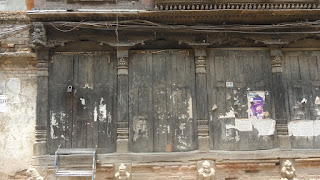It turned out to be a rather whirlwind trip through Varanasi (Beneras), Sarnath, Gaya, Bodhgaya, Allahbad. In many ways, felt like I was on a Buddhist circuit. But nearly not enough to soak in the place that was Beneras. I've heard stories, seen pictures and studied maps of the historic city with its narrow lanes and heard tales of the mighty river 'Ganga' that appears like an ocean to a first timer, but alas - two days wasn't quite enough.
I did manage to go to quite a few places, the ancient Kashi Temple through the narrow lanes, feasted on the famous Benerasi Paan, Rabadi and Tomato Chaat but it wasn't enough. I hope to be back soon and explore the narrow lanes and its magnificient ghats more.
The thing about walking though the narrow lanes at least the ones that led to the Kashi Temple was how different it felt from walking along similar narrow lanes in other places. May be it was the openess - all the shops essentially open out to the street, or the relatively low height buildings, the lack of cantileverd projections butting out above your head - the walk, against all expectation did not feel cramped. Despite the vendors trying to lure you to their shops, it- the walk, wasn't unpleasant. That's something I take from the experience.
Another aspect has to be the experience of the temple smack in the middle of this old city. I have to admit, I'm used to and almost expect religious buildings at a stand alone structure with a decent amount of foreground. This was different, one minute you are walking between these shops, and the next step you are literally walking through metal detectors to get inside the temple complex. It certainly was a first for me.
Along the way, we also got to see some of the Mauryan Stupas at Kesharia and Kohlua, possibly dating back to the reign of Emperor Ashok.
The thing that stood out most for me, was this contrast between the sense of place between Gaya and Bodhgaya. The difference was stark. And yet both places are so intertwined historically. Its puzzling how we human beings can create such different built-up environments even within such close proximity.
To be continued...
Along the way, we also got to see some of the Mauryan Stupas at Kesharia and Kohlua, possibly dating back to the reign of Emperor Ashok.
The thing that stood out most for me, was this contrast between the sense of place between Gaya and Bodhgaya. The difference was stark. And yet both places are so intertwined historically. Its puzzling how we human beings can create such different built-up environments even within such close proximity.
To be continued...
 |
| Kohlua Excavated Ruins (Dec. 2016) |
 |
| The banks of Gaya (Dec. 2016) |
 |
| Narrow lanes of Gaya (Dec. 2016) |
 |
| One of the access to the main Ghat area (Dec. 2016) |
 |
| Electric Tuk Tuks at Bodhgaya (Buddha Mahabodhi Temple) (Dec. 2016) |
 |
| Evening Ganga Aarti at Varanasi Ghat (Dec. 2016) |
 |
| Asokan Stupa at Kesharia (Dec. 2016) |
 |
| Wooden Stove at Gaya (Dec. 2016) |












































